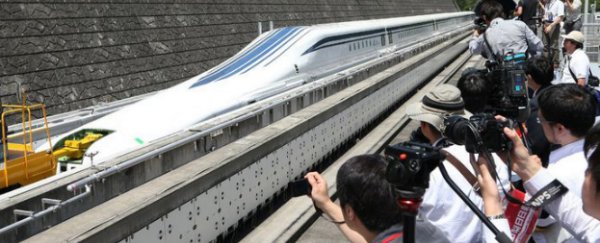
Hurtling across Japan at 500 km/hour sounds pretty terrifying to us. But Japan has now built a maglev train that's capable of hitting 501 km/h, and the BBC footage (above) of the first 100 passengers riding the train looks much smoother than we'd imagined.
The trial journey only stretched 42.8 km along a route between Uenohara and Fuefuki, two cities west of Tokyo. But this is just the first part of a track that will eventually connect Tokyo with Nagoya in the country's centre.
That journey currently takes trains around 80 minutes, but the new maglev technology will cut the time in half to just 40 minutes. The full route is expected to be completed by 2027.
Once up and running, the train will be even faster than the Shanghai Maglev Train, which is currently the fastest commercial train in the world, capable of reading speeds of 431 km/hour.
Maglev technology, which is an abbreviated name for magnetic levitation, works by actually floating a train a short distance off its tracks and powering it forward using magnetic fields, rather than wheels, axels and bearings.
This means the trains are unaffected by weather, such as heavy rain on the tracks, and they're also smoother and often quieter than the trains we're used to now.
Which explains why the record-breaking ride in Japan looked like so much fun - we love the excitement of the passengers when the train hits 501 km/h.
And if you think this is impressive, China is working on creating a maglev train inside a near-vacuum that, in theory, can travel 2,900 km/h - three times faster than a plane - due to the lack of air resistance.
Meanwhile, Australia is stuck with trains that generally max out at a comparative crawl of around 160 km/h, and in the US the top speed of rail transport is around 240 km/h.
But when you look around the world, the future of transport is looking pretty bright.
